intro
Andreas Kavazis, Ph.D. serves as the director of the Muscle Biochemistry Laboratory. He and his graduate students investigate molecular events occurring in muscle and other tissues.
His research agenda focuses on understanding the molecular, cellular, and physiological adaptations that occur in different tissues, including skeletal muscle, cardiac muscle, adipose tissue, liver, etc. He examines the tissues during periods of different metabolic loads, such as exercise, inactivity, reproduction, lactation, etc. Specifically, he focuses on mitochondria because of their key role in bioenergetics and cellular metabolism. Mitochondria produce ATP, or energy, through the Krebs cycle. Kavazis studies the mitochondrial adaptations that occur during these various metabolic states.
Research
Some of Kavazis’ publications include:
Min K, Kwon OS, Smuder AJ, Wiggs MP, Sollanek K, Christou DD, Yoo JK, Hwang MH, Szeto HH, Kavazis AN, and Powers SK. Increased mitochondrial emission of reactive oxygen species and calpain activation are required for doxorubicin-induced cardiac and skeletal muscle myopathy. J Physiol. 593:2017-3206. 2015.
Kavazis AN, Smuder AJ, and Powers SK. Effects of short-term endurance exercise training on acute doxorubicin-induced FOXO transcription in cardiac and skeletal muscle. J Appl Physiol. 117:223-230. 2014.
Smuder AJ, Kavazis AN, Min K, and Powers SK. Exercise protects against doxorubicin-induced oxidative stress and proteolysis in skeletal muscle. J Appl Physiol. 110:935-942. 2011.
Kavazis AN. Exercise preconditioning of the myocardium. Sports Med. 39:923-935. 2009.
Kavazis AN, Alvarez S, Talbert E, Lee Y, and Powers SK. Exercise training induces a cardioprotective phenotype and alterations in cardiac subsarcolemmal and intermyofibrillar mitochondrial proteins. Am J Physiol Heart Circ Physiol. 297:H144-152. 2009.
Kavazis AN, Talbert EE, Smuder AJ, Hudson MB, Nelson WB, and Powers SK. Mechanical ventilation induces diaphragmatic mitochondrial dysfunction and increased oxidant production. Free Radic Biol Med. 46:842-850. 2009.





